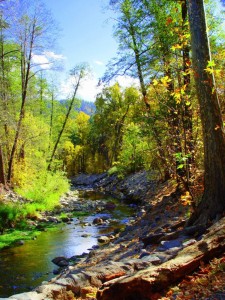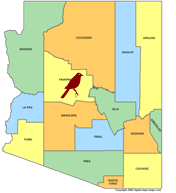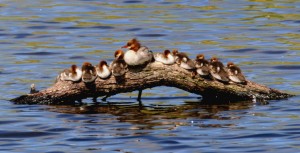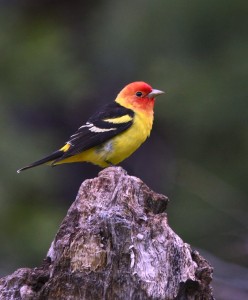Site Steward: Northern Arizona Audubon Society
Size: 5.8 square miles, 3,685 acres
Identified: 01/2004 Recognized: 04/2006
Visiting the IBA: Red Rock State Park is immediately south of Sedona. The best way to the park is travel on I-17 to Arizona highway 260 west to Arizona Highway 89A and north to Red Rock Loop Road. Page Springs and Bubbling Ponds Fish Hatchery is north of Cornville. Take the Rim Rock exit on I-17 and travel west to Page Springs Road, immediately east of Cornville, and travel north to the parking lot and access to the hiking trails and observation platform. The Verde Valley Birding Trail has excellent information for birding in this area. http://verdebirdingtrail.com/birdsites/hotspot/
Ownership: Arizona State Parks, Arizona Game and Fish Commission, Coconino National Forest, Private (with permission).
Site Description: The identified IBA is the river corridor, extending up-slope to approximately the rim level on either side of the river extending from Red Rock State Park to just south of Page Springs Fish Hatchery. Vegetation is a mix of riparian gallery (cottonwood/willow/sycamore), mesquite/ hackberry bosque, recovering floodplain terrace and upslope prickly pear grassland. The creek is perennial and the hatchery ponds provide seasonal habitat for migrating waterfowl and waterbirds.
Birds: Many cavity nesting species are supported in great abundance because of old growth gallery forest within this IBA. Species of special conservation status and interest that use the habitats within this IBA include:
Year-round: American Kestrel, Common Merganser, Wood Duck, Ladder-backed & Gila Woodpeckers, Northern Flicker, Bewick’s Wren, Bridled Titmouse, and Abert’s Towhee.
Breeding: Common Black-Hawk, Yellow-billed Cuckoo (rare), Belted Kingfisher, Brown-crested Flycatcher, Ash-throated Flycatcher, Violet-green Swallow, Lucy’s Warbler, Yellow Warbler, Summer Tanager, and Bullock’s Oriole.
Migration: Willow Flycatcher, Olive-sided Flycatcher, Hammond’s Flycatcher, Dusky Flycatcher, Warbling Vireo, Yellow-rumped Warbler (Audubon’s), MacGillivray’s Warbler, Virginia’s Warbler, Black-throated Gray Warbler, Nashville Warbler, and Wilson’s Warbler, Western Tanager, and Lazuli Bunting.
Winter: Waterfowl, Bald Eagle, Osprey, Red-naped Sapsucker, Ruby-crowned Kinglet, Dark-eyed Junco.
eBird focus species: Breeding season: Common Merganser, Belted Kingfisher, Yellow-billed Cuckoo, Bell’s Vireo, Lucy’s Warbler, Abert’s Towhee.
Conservation Issues: Irrigation water diversions, development, invasive plants (Russian olive, arundo, salt cedar)
Complete eBird.org Checklist of birds Reported for Lower Oak Creek IBA
Location: 34.7932° N: 111.9001° W
County: Yavapai
Site Status: Identified 01/2004, Recognized 04/2006
Ownership: Arizona Game and Fish, Arizona State Parks, Coconino National Forest, Private
Area: 5.8 square miles, 3,685 acres
Criteria: D1: State: Species of Conservation Concern
D3: State: Species in rare/unique habitat – Riparian
D4vii: State: Outstanding landbird stopover
Site Description: The identified IBA is a 10 mile stretch of Lower Oak Creek just a mile or two downstream from where it emerges from the steep canyon walls among the red ramparts of Sedona -the IBA is the river corridor from Red Rock State Park to just south of Arizona Game and Fish Department (AGFD) Page Springs Fish Hatchery. Most of the land in-between the park and the hatchery is U.S. Forest Service, Coconino National Forest, interspersed with mature riparian gallery forests on private properties at Echo Valley (20 acres), Hidden Valley (20 Acres), and Deer Creek (20 Acres).

| Vegetation Description | Acres |
| PINYON – JUNIPER | 1870 |
| SONORAN SAVANNAH GRASSLAND | 679 |
Ornithological Summary:
| Species or group | Season | Maximum | Year |
| Landbird Stopover | Spring & Fall passage | 7 Species of Conservation Concern: SW Willow Flycatcher, Olive-sided Flycatcher, Gray Flycatcher, Lucy’s Warbler, MacGillivray’s Warbler, Virginia’s Warbler, Black-throated Gray Warbler (plus neotropical migrants: Hammond’s Flycatcher, Dusky Flycatcher, Warbling Vireo, Western Tanager, Nashville Warbler, and Wilson’s Warbler) | 2003 |
| Riparian Habitat | Breeding | 7 Species of Conservation Concern: Common Black-Hawk, Yellow-billed Cuckoo, Belted Kingfisher, Lucy’s Warbler, Yellow Warbler, Bell’s Vireo, Abert’s Towhee2 SCS Species (Period | 2003 |
| “ “ | Winter | Red-naped Sapsucker, Osprey (: 3 individuals) | 2003 |
| Wood Duck | Breeding | 50 pairs | 2003 |
| Common Merganser | Winter | 19 individuals | 2002 |
| Common Black-Hawk | Breeding | 7 individuals | 2003 |
| Bald Eagle | Winter | 4 individuals | 200 |
Lower Oak Creek supports the broad species diversity that accompanies the convergence of the northern plateau with the rising arid desert lands from the south. This riparian corridor IBA is exceptional for Arizona in two respects, 1) it is a significant migration corridor that supports exceptional landbird diversity and abundance in spring and fall migration, and 2) it is a premier riparian habitat corridor supporting numerous riparian obligate species, many of which are species of conservation concern in Arizona. Audubon WatchList species that breed within the IBA include: Bell’s Vireo, Lucy’s Warbler and Abert’s Towhee. Audubon WatchList migrants passing through Oak Creek IBA include Southwestern Willow Flycatcher, Olive-sided Flycatcher, and Virginia’s Warbler. Notable populations of rare species in Arizona also occur, such as Wood Duck, Common Merganser, Common Black-Hawk, and Yellow-billed Cuckoo.
Many cavity nesting species are supported in great abundance because of old growth gallery forest within this IBA, they include: American Kestrel, Common Merganser, Gila Woodpecker, Ladder-backed Woodpecker, Northern Flicker, Bewick’s Wren, Bridled Titmouse, Brown-crested Flycatcher, Ash-throated Flycatcher, Violet-green Swallow and Lucy’s Warbler.
Habitat and Access: The 175-acre property of Arizona Game and Fish Department (AGFD), Page Springs Fish Hatchery, comprises riparian gallery (cottonwood/willow/sycamore), mesquite / hackberry bosque, recovering floodplain terrace and up-slope prickly pear grassland. Other mature riparian gallery forests on well-developed floodplains occur at Echo Valley, Hidden Valley, Deer Creek, and Red Rock State Park. The identified IBA is the river corridor, extending up-slope to approximately the rim level on either side of the river extending from Red Rock State Park to just south of Page Springs Fish Hatchery. Northern Arizona Audubon Society (NAAS) and AGFD jointly manage the vegetated land at Page Springs for the benefit and diversity of wildlife. A public-access trail system with educational signage has been put in place and plant restoration programs are on-going.
Red Rock State Park is a 286-acre nature preserve and environmental education center with a mission to preserve the riparian habitat of Oak Creek, provide environmental education and limited passive recreation. A five mile trail network and environmental education center are at the park. (http://www.pr.state.az.us/Parks/parkhtml/redrock.html).
Conservation Issues: Most all southwestern waterways are at risk of dewatering. While most of the large scale irrigation extraction from Oak Creek is downstream of the IBA (two irrigation ditches originate from the Page Springs property) the rapid conversion of pasturelands to ranchettes and residential lots watered by new private wells in the riparian zone amplifies both the loss of water and loss of riparian gallery. The spread of invasive non-native plants is of considerable concern. Russian olive and tamarisk are preventing natural re-colonization of some riparian areas following flooding. The USFS lands are subject to cattle grazing. Plant restoration and nest box programs are on-going at Page Springs Fish Hatchery and at Hidden Valley. Efforts are under way to control Russian olive, tamarisk and other invasive non-native plants that are preventing re-colonization of native plants following flooding. Partners of this IBA are advocates for water conservation. NAAS is the steward for this site. More information about Northern Arizona Audubon Society and how you can help as a volunteer can be found at http://www.









